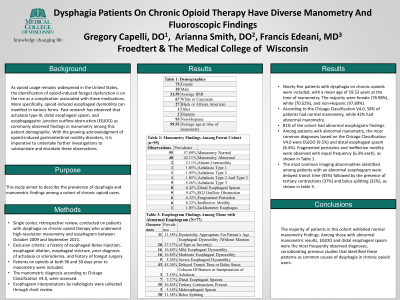Monday Poster Session
Category: Esophagus
P1841 - Dysphagia Patients on Chronic Opioid Therapy Have Diverse Manometry and Fluoroscopic Findings
Monday, October 23, 2023
10:30 AM - 4:15 PM PT
Location: Exhibit Hall

Has Audio

Arianna Smith, DO
Medical College of Wisconsin
Milwaukee, WI
Presenting Author(s)
Gregory Capelli, DO, Arianna Smith, DO
Medical College of Wisconsin, Milwaukee, WI
Introduction: Chronic opioid use has been associated with esophageal dysmotility, with previous studies highlighting achalasia type III, distal esophageal spasm, and esophagogastric junction outflow obstruction (EGJOO) as common findings on manometry. Given the increasing recognition of opioid-induced GI motility disorders, further investigation is needed to validate and describe these observations. This study aimed to describe the prevalence of dysphagia and manometric findings among a cohort of chronic opioid users.
Methods: A retrospective review was conducted on patients with dysphagia on chronic opioid therapy who underwent high-resolution manometry and esophagram between October 2009 and September 2021. Exclusion criteria included a history of esophageal Botox injection, esophageal dilation, esophageal stricture, prior diagnosis of achalasia or scleroderma, and history of foregut surgery. Patients on opioids at both 90 and 30 days prior to manometry were included. The manometric diagnosis according to Chicago Classification V4.0, were assessed. Esophagram interpretations by radiologists were collected through chart review.
Results: Ninety-five patients with dysphagia on chronic opioids were included, with a mean age of 59.53 years at the time of manometry. The majority were female (78.98%), white (70.52%), and non-Hispanic (97.89%). According to the Chicago Classification V4.0, 58% of patients had normal manometry, while 42% had abnormal manometry. Additionally, 81% of the cohort had abnormal esophagram findings. Among patients with abnormal manometry, the most common diagnoses based on the Chicago Classification V4.0 were EGJOO (9.5%) and distal esophageal spasm (8.4%). Fragmented peristalsis and ineffective motility were observed with equal frequency (6.3% each), as shown in Table 1.
Discussion: The majority of patients in this cohort exhibited normal manometry findings. Among those with abnormal manometric results, EGJOO and distal esophageal spasm were the most frequently observed diagnoses, corroborating previous studies that identified these patterns as common causes of dysphagia in chronic opioid users.
Disclosures:
Gregory Capelli, DO, Arianna Smith, DO. P1841 - Dysphagia Patients on Chronic Opioid Therapy Have Diverse Manometry and Fluoroscopic Findings, ACG 2023 Annual Scientific Meeting Abstracts. Vancouver, BC, Canada: American College of Gastroenterology.
Medical College of Wisconsin, Milwaukee, WI
Introduction: Chronic opioid use has been associated with esophageal dysmotility, with previous studies highlighting achalasia type III, distal esophageal spasm, and esophagogastric junction outflow obstruction (EGJOO) as common findings on manometry. Given the increasing recognition of opioid-induced GI motility disorders, further investigation is needed to validate and describe these observations. This study aimed to describe the prevalence of dysphagia and manometric findings among a cohort of chronic opioid users.
Methods: A retrospective review was conducted on patients with dysphagia on chronic opioid therapy who underwent high-resolution manometry and esophagram between October 2009 and September 2021. Exclusion criteria included a history of esophageal Botox injection, esophageal dilation, esophageal stricture, prior diagnosis of achalasia or scleroderma, and history of foregut surgery. Patients on opioids at both 90 and 30 days prior to manometry were included. The manometric diagnosis according to Chicago Classification V4.0, were assessed. Esophagram interpretations by radiologists were collected through chart review.
Results: Ninety-five patients with dysphagia on chronic opioids were included, with a mean age of 59.53 years at the time of manometry. The majority were female (78.98%), white (70.52%), and non-Hispanic (97.89%). According to the Chicago Classification V4.0, 58% of patients had normal manometry, while 42% had abnormal manometry. Additionally, 81% of the cohort had abnormal esophagram findings. Among patients with abnormal manometry, the most common diagnoses based on the Chicago Classification V4.0 were EGJOO (9.5%) and distal esophageal spasm (8.4%). Fragmented peristalsis and ineffective motility were observed with equal frequency (6.3% each), as shown in Table 1.
Discussion: The majority of patients in this cohort exhibited normal manometry findings. Among those with abnormal manometric results, EGJOO and distal esophageal spasm were the most frequently observed diagnoses, corroborating previous studies that identified these patterns as common causes of dysphagia in chronic opioid users.
Disclosures:
Gregory Capelli indicated no relevant financial relationships.
Arianna Smith indicated no relevant financial relationships.
Gregory Capelli, DO, Arianna Smith, DO. P1841 - Dysphagia Patients on Chronic Opioid Therapy Have Diverse Manometry and Fluoroscopic Findings, ACG 2023 Annual Scientific Meeting Abstracts. Vancouver, BC, Canada: American College of Gastroenterology.
